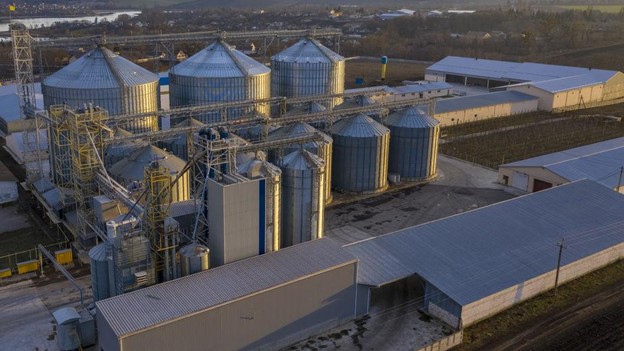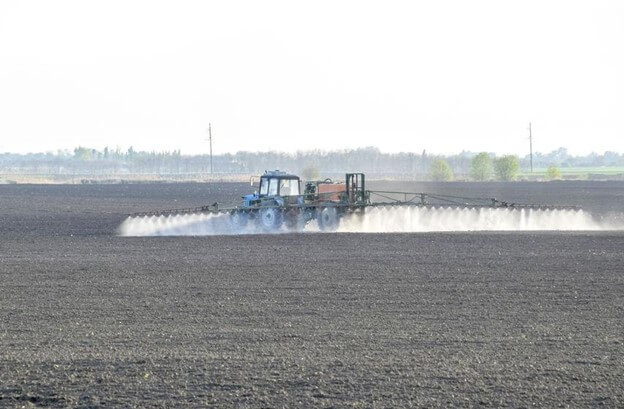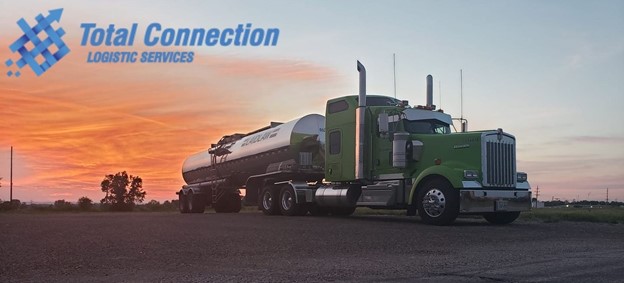Liquid Bulk fertilizer transport is stressful enough. There are a lot of processes, paperwork, and tracking to be done. But if you think that is stressful, try bulk liquid fertilizer transport when the fertilizer contains hazardous materials — and boy, many fertilizers do!. It’s another world of stress, with countless regulations and regulatory bodies brandishing their penalties like whips in the air for when you break a rule.
Your business doesn’t need the extra pressure. When you partner with a reliable agricultural logistics company like Total Connection, you can concentrate on your business without the constant yapping of regulations at your heels. The experienced logistics company will handle your liquid bulk fertilizer transport for you.
Here, you’ll learn everything about the liquid bulk transport of fertilizers that contain hazardous chemicals and the regulations that surround them. You’ll also learn how to transport your liquid bulk fertilizer. Then you’ll see how Total Connection takes these off of your shoulders.
Content
Part A
The Challenge of Shipping Liquid Bulk Fertilizers
Part B
HAZMAT Classifications for Fertilizers
Regulations for Shipping Fertilizers Containing Hazardous Materials
Part C
Important Steps in Liquid Bulk Fertilizer Transport
Part D
How Total Connection Eases Your Liquid Bulk Fertilizer Transport
The Challenge of Shipping Liquid Bulk Fertilizers
Plants require a lot of nutrients for healthy growth. Crops need potassium to help them grow roots that are deep and strong, for instance. Nitrogen boosts the development of plant stems and leaves, especially when the plants are in the mid-stages of their lifespan. And phosphate strengthens root, leave, and stem systems of plants, especially in young plants.

Like these three, there are other nutrients that a plant should not do without. About 17 of them. But unfortunately, not all soils contain them all at once. Thanks to fertilizers, however, you can give the soil a boost in the nutrients it is deficient in. And thanks to bulk fertilizer transport as well, allowing you to spend less for more value and quantity.
However, bulk fertilizer transport comes with its challenges, with the major one arising from the unavoidable use of hazardous materials (HAZMAT) in many fertilizers. And if you were to get careless with these materials, all hell could break loose.
As a result, you must be extra careful and smart when dealing with bulk fertilizer shipping matters. A good place to start is to understand the hazardous classification of your fertilizer shipment, irrespective of whether you are a farmer or a fertilizer distributor.
HAZMAT Classifications for liquid chemical Fertilizers
Many fertilizers contain compounds that could be dangerous when they are not being used on the farm. Ammonium nitrate, for instance, is not only an important ingredient in fertilizers but also in explosives. “Why is a hazardous material used in making fertilizers,” you may ask. It is because ammonium nitrate is an inexpensive source of nitrogen. And since nitrogen is needed in large quantities on farms, it is hard to completely scrap the use of the potentially dangerous chemical.
Sulfur is another important component in many fertilizers, but it could be dangerous when mishandled. Because of the potential dangers that accompany the use of these chemicals in fertilizers, many regulations control and monitor the shipping of these hazardous chemicals.
The Hazardous Materials Regulations (HMR) of the United States Department of Transportation (USDOT) classifies hazardous materials into nine major categories. Many fertilizers fall into some of the categories:
Hazardous Materials Classes Fertilizers May Belong To
Of the nine classes of hazardous materials, fertilizers may fit into seven of them.
● Class 2: Gases
Some fertilizers contain sulfur. And under the wrong conditions, these fertilizers could emit some gases that are dangerous to the humans close by.
● Class 3: Flammable Liquids
Not all liquid fertilizers can ignite, but those that can fall into this category.
● Class 4: Flammable Solids
Apart from granular fertilizers, liquid Fertilizers that are combustible when wet fall into this category.
● Class 5: Oxidizers and Peroxides
Ammonium nitrate is an oxidizer. The compound could also irritate your lungs and eyes when it comes in contact with them. It could even be a recipe for disaster when it spills in large quantities.
● Class 6: Poisons
This class belongs to fertilizers that are poisonous when they get into your body.
● Class 8: Corrosive
Some fertilizers are also considered corrosive.
● Class 9: Miscellaneous Hazardous Materials
If you want to be sure of the hazard classifications of your shipment, refer to this Hazard Determination document provided by the Occupational Safety and Health Administration (OSHA). Your fertilizer manufacturer or importer should also provide you with labels for hazard classes of your shipment.
Also, never ship fertilizer containing hazardous materials without providing the logistics company with your Safety Data Sheet (SDS). This way, everyone who is involved in the shipping is certain about what materials are being transported. The SDS contains details about the chemicals that make up the fertilizer. It also describes safety measures, such as cleanup procedures, fire-fighting techniques, and first aid measures, in case of accidents.
Regulations for Shipping Fertilizers Containing Hazardous Materials

The Federal Motor Carrier Safety Administration (FMCSA) of the USDOT has a lot of regulations shippers of hazardous materials must adhere to. The body has a document where it describes how to comply with federal HMR. Although the document addresses the transport of hazardous materials by highway, it also applies to:
- HAZMAT transport within and between states, and to foreign countries through aircraft, motor vehicles, rail cars, and vessels.
- Any form of representation that suggests that an aircraft, container, motor vehicle, package, railcar, or vessel contains hazardous materials. Even in comic books.
- The process of fabrication, maintenance, manufacture, marking, reconditioning, testing, or repairing of a container or package that is meant for use in the transportation of HAZMAT.
When you are transporting fertilizers containing hazardous materials (HM), there are responsibilities that FMCSA expects of you. These responsibilities are:
● Shipping papers.
Carriers of HM are never to be without shipping papers during transport. The shipping papers contain all the details of the hazardous materials you are transporting according to HMR.
● Marking and placarding your vehicle.
The shipper of your fertilizers should give you placards to attach to the outside of your transport vehicle. You must attach these placards where they are easily visible on your transport vehicle so that it effectively communicates its hazardous material content.
● Loading and unloading responsibilities.
There are a lot of packaging responsibilities for HM, and you can find them in Title 49 of the Code of Federal Regulations from par 174 to 177. Here, the CFR gives requirements for transporting hazardous materials by air, highway, rail, and water. And in the 177.834-177.854 of part 177, it discusses the specific requirements for loading and unloading the materials.
● Compatibility.
Compatibility addresses situations where the hazardous materials are being transported in multi-compartmented tanks in the transport vehicles. This is because some chemicals that are incompatible with one another and should never be transported in the same cargo. For instance, you must not transport cyanide and its mixtures, found in some fertilizers, with acids, irrespective of the hazard class.
● Blocking and bracing.
This responsibility covers the proper containment of hazardous materials during transportation. It requires that the materials are well contained and secured to avoid leakages or spills because of inadequate blocking and bracing.
● Incident reporting.
In the case of incidents, a carrier must immediately notify the Department as early as they can. Eight consequences of these incidents warrant reporting when they occur. Death, fire outbreak, serious injury, public evacuation, and spillage are some of these consequences. You are to report incidents to the DOT and/or CDC. However, this emergency report does not replace the formally written incident report the carrier is still responsible for providing.
● Security plan.
A security plan cuts the amount of liability you may be exposed to if an illegal act involves your potentially dangerous fertilizer.
● Employee training.
It is the responsibility of shippers and carriers to invest in the training of employees who would handle the hazardous materials. This training should include safety and security training, first aid training, and other important training sessions. This training should not only be limited to new employees, but it should also cover every other employee regularly.
● Emergency response information.
You must include emergency response information in the employee training sessions. This information should contain who the employees are to contact. You may contact the National Response Center (NRC) for spills via telephone at (800) 424-8802. And for incidents that involve etiologic agents (infectious hazardous materials), report to the Center for Disease Control (CDC) at (800) 232-0124 instead of the NRC. Employees should memorize emergency response phone numbers.
Exceptions to Hazardous Fertilizer Transport
As you might have already guessed, the rules are voluminous. And with regulations such as this, exceptions litter the whole place.
There are exemptions from requirements on employee training, emergency response information, and some packaging requirements if you are a farmer transporting hazardous fertilizers (apart from Class 2 gases) within a 150-mile radius of your farm. But these exemptions only apply to when:
- A farmer who is an intrastate private motor carrier transports the agricultural product
- You are already transporting your agricultural product in compliance with the requirements of the state you’re transporting in, and you have been specifically authorized by a state statute that was in effect before the 1st of October, 1998.
- The total amount of hazardous
agricultural product being transported in a vehicle does not exceed
- 7,300 kg (16,094 lbs) of ammonium nitrate fertilizer.
- 1900 L (502 gallons) of liquid or gaseous agricultural products.
- 2,300 kg (5,070 lbs) of solid agricultural products.
The HMR also lists some other exceptions relating to the Agricultural Operations Section. These exceptions concern you if
- You are a private motor carrier who is transporting less than 220 L (58 gals) of formulated liquid agricultural products with proper transporting equipment. This transporting equipment includes several closures to a closed mixed system, which is fully equipped with positive dry disconnect devices from right before transit till the products get to their final destination.
- The products are only nurse tanks of anhydrous ammonia.
- Or trade materials.
Important Steps in Liquid Bulk Fertilizer Transport
The steps include how to get HAZMAT verified, how to label your containers and tankers properly, and general safe handling tips for liquid bulk fertilizers.
These processes are very important because liquid bulk transport of any hazardous material requires special attention. A little leak could contaminate water bodies, cause injuries to people, and lead to loss of lives and property.
But first, there is an alternative to liquid fertilizers that we just can’t ignore: dry or granular fertilizers. Apart from the obvious difference in the forms of the fertilizers, how are they different from each other? And what advantages do liquid fertilizers have over dry fertilizers?
Liquid Fertilizer vs Dry (Granular) Fertilizer
We base our comparison on the advantages one has over the other
The advantages of liquid fertilizers over granular fertilizers.
- Liquid fertilizers are easy to apply, especially on large farms.
- Plants and soils absorb liquid fertilizers faster than granular fertilizers, thanks to the liquid form of the fertilizers
- Liquid fertilizers are better than dry fertilizers for starter and in-seasons applications.
- You can easily blend liquid fertilizers with other crop protection products.
- It is easier to attain a uniform application over a large farm with liquid fertilizers.

The advantages of Granular Fertilizers over Liquid fertilizers.
- Because they are slowly absorbed into the soils and plants, their effects last longer. And you don’t need to apply them as often as you would need to apply liquid fertilizers.
- There is no risk of them sinking into the ground when they are applied, unlike the way it is with liquid fertilizers that aren’t well prepared.
- Better for intensive pre-plant applications than liquid fertilizers.
So which is better, liquid fertilizers or dry fertilizers? They are both good for various purposes, so one isn’t necessarily better than the other. And farmers often use the two kinds of fertilizers over several stages of their farming process.
But before you jump to a conclusion about whether to use liquid or dry fertilizers, consider which is better for bulk transport.
Liquid Bulk Fertilizer Transport vs Dry Bulk Fertilizer Transport?
Transporting your bulk fertilizer in liquid form beats dry from in the following ways:
● Space and Cost Efficiency.
If a tanker could carry liquid or dry bulk fertilizer, it would carry more liquid fertilizer than dry fertilizer. And because you save more space with bulk liquid fertilizer shipping, you can transport more at once and save cost.
● Greater control over your products.
Imagine your crops are in dire need of nutrients, and you need to revitalize them quickly. Dry fertilizers are already out of the question because of their delayed effectiveness. But liquid fertilizers can quickly help your crops back to health. Not just because of their liquid form, but also because liquid fertilizer tankers have features like in-transit heating systems that keep your fertilizers at an optimal temperature at delivery. This way, your fertilizer is ready for use as soon as it gets to you.
● Ease of unloading.
You would have to depend on forklifts and heavy manual labor to unload your dry fertilizers from the truck. This is a waste of time, human labor, and money on extra employee wages. But when you opt for liquid bulk fertilizer transport, you unload with hoses into your container. You save time, rely on less manual labor, and save more on employee wages.
● Damage Protection.
When your dry bulk transport truck drives under suboptimal conditions, your bags, skids, and totes of dry fertilizers are prone to damage and tear. This could lead to the loss of valuable products, making you get less for your money. But liquid bulk fertilizer tankers are built to withstand abnormal road conditions. This way, your products never waste during transit.
How to be HAZMAT Certified
Your employees who are in direct control of the transport and removal of your hazardous materials may need HAZMAT certification. There are several HAZMAT fields to get certified in, including management, training, or shipping. However, the USDOT itself is not in charge of the certification. There are HAZMAT schools where you could take the training and get certified.
The process of getting HAZMAT certified involves HAZMAT training, which often includes learning all HMR requirements. The certification is an optional process for employees, and you or your employees won’t get into trouble for not having them. However, anyone who handles your hazardous materials MUST go through HAZMAT training. This part is non-negotiable.
Proper Labelling of HAZMAT Containers and Tankers
There is a label that goes with each hazard classification. The labels are the same all over the world to avoid any confusion. And they must be placed on the bodies of the containers so that they can be visible from some distance away.
Without these labels, it would be hard to determine the amount of risk involved when an accident that involves a HAZMAT container occurs. And since the hazardous content could be anything from flammable, corrosive, radioactive, or even toxic, going about without these labels could incur some heavy penalties.
With tankers or any vehicle carrying potentially dangerous materials, they must always have hazard classification placards on them. The placards are like the labels. And they must be visible on all sides of the tanker.
Safe handling of Liquid Bulk Fertilizers

Every employee that would handle these potentially dangerous chemicals at any point must be well trained. Your carriers must first be licensed to drive a tanker truck. Then they should be familiar with laws concerning the transport of hazardous materials. Also, your carriers should always have a copy of the SDS your shipper provides for the fertilizer you are transporting.
How Total Connection Eases Your Liquid Bulk Fertilizer Transport
All the rules and regulations surrounding bulk chemical transport could be hard to follow, especially for fertilizers containing hazardous materials. And the law is unforgiving when you break any of them. Keeping up with the regulation updates is another challenge on its own. And don’t forget the paperwork that comes with the entire process. Then comes the anticipation that comes with tracking your shipments. The processes are so demanding that if you created a department within your company or farm to handle them, it would be worth it.
But the good news is that you don’t have to do all those when you partner with a reliable and competent logistics company like Total Connection. We let you concentrate on your business and nothing more. We will handle the delivery for you and obey all the rules and regulations on your behalf.
Benefits of Shipping your Liquid Bulk Fertilizer with Total Connection
Here’s how Total Connection eases liquid bulk fertilizer transport for you.
● Vast experience.
After 25 years in the business of shipping agricultural chemicals, we have all the experience it takes to handle your bulk liquid fertilizer transport smoothly. Whatever kind of liquid fertilizer you intend to ship, whether organic, HAZMAT, or any other kind, thousands of other clients have trusted us to ship it for them. So, yours wouldn’t be a problem.
● Emergency on-demand coverage.
We are a private family-owned business. We don’t have unnecessary “delivery processing hierarchies“ that do nothing but slow down your delivery process. Instead, we deliver your bulk fertilizer as soon as you want it. Contact Total Connection anytime, 24/7, to make that last-minute shipment.
● Cost-Efficient and Insured Delivery.
You don’t have to take up more liability than you need to. Our services are inexpensive and we always insure your products that are with us. So, even in an extremely rare case of an accident, you still have nothing to worry about.
● Flexibility.
This is where we most pride ourselves in. We immerse ourselves into your business when you partner with us so that we can provide solutions that are best suited to you. We do last-minute reschedules, and offer you just the perfect quote for your business, just so that we don’t interrupt your supply chain.
Conclusion
Liquid bulk fertilizer transport is a complex process, but you don’t have to do it on your own. Relieve your business of the stress and pressure of bulk fertilizer transport by filling the quote form below.
